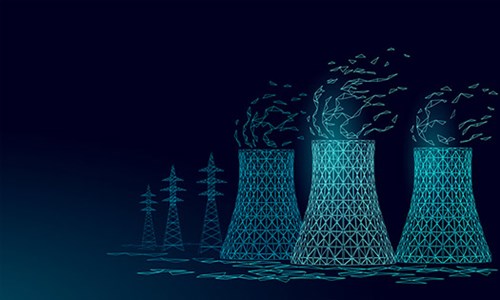How intelligent automation is helping the industry drive sustainability goals
The oil and gas (O&G) industry is in a state of flux. It’s facing all-time high energy prices and pressures for less carbon-intensive energy systems; demands for clean energy to address the climate crisis; tight margins; and talent shortages. The industry, well aware of these issues and the growing need to evolve for a viable future, is seeking ways to reduce CO2 and methane emissions, as well as source alternatives. But effective change will require substantial investment, innovation, and research and development, at a much faster pace than we currently see.
Intelligent automation (IA) has a role in making this happen, Fig. 1. An astonishing 81% of O&G executives agree that a digital-first workforce needs to be developed over the next ten years. Regulations and societal demands for reducing fossil fuel dependency will only continue. IA helps by driving innovation, filling some skills gaps for engineers, and enhancing data usage and operational efficiency. Much of this sector is process-driven, yet many of these tasks are still operated manually and with legacy systems. This creates value-obstructing data siloes, which IA can help break down—offering insights and analysis to inform progress promoting decision-making. Together, these outcomes enhance cash flows while helping meet emerging sustainability objectives and requirements.

FIG. 1. Intelligent automation (IA) has a role in making clean energy happen.
THE O&G ROLE IN TODAY’S GLOBAL ECONOMY?
This year, O&G will make up over half of the global energy supply, which shows the world’s continued dependence on these commodities. Alternative energy sources have not yet advanced to the point where we can effectively use them to replace all the world’s O&G demands. Developing economies will struggle to facilitate their industrial needs without oil and gas. They have not had the capacity of developed countries to invest in clean energies and technologies.
Although the world is not at the point of saying goodbye to O&G, this does not absolve us of the responsibility to transition to a renewable energy supply. The O&G industry has a prominent role to play in bringing forward a global net-zero economy (Fig. 2), which is estimated to need $3.5 trillion in annual investment through 2050. Fossil fuels—coal, oil and gas—are reputedly the most significant contributors to climate change, accounting for more than 75% of global greenhouse gas emissions, according to some scientific sources.

FIG. 2. The O&G industry has a prominent role to play in bringing forward a global net-zero economy by bringing forth its considerable knowledge and capabilities.
The industry is working to make progress regarding environmental, social and governance (ESG) issues, as doing so has become an economic, political and reputational imperative. Several O&G companies have established net-zero-emissions targets and are persevering with decarbonization efforts, despite the economic volatility of the past few years. For example, Occidental Petroleum, one of the largest international oil companies in the U.S., has partnered with Carbon Engineering, a Canadian-based clean energy company, to build a plant intended to capture half a million metric tons of CO2 every year. Also, in January 2022, ExxonMobil announced its target to achieve net-zero greenhouse gas emissions by 2050.
HOW IA HELPS THE INDUSTRY REACH ESG TARGETS
The sector’s efforts to mitigate the effects of climate change center around three primary areas: reducing CO2 emissions, reducing methane emissions, and recycling CO2, Fig. 3. An IA formula can support forward movement on these goals, replacing manual tasks with automation and relieving people to unleash efficiency and focus on value-adding, transformative work.

FIG. 3. IA can help the industry reach ESG targets that include reducing CO2 emissions, reducing methane emissions, and recycling CO2
Any movement in this space needs substantial research and development, combined with innovation. This requires effective and complete data usage, which is impossible with outdated IT infrastructures and siloed information. Intelligent automation can connect these legacy systems; consolidate the reams of structured and unstructured data commonplace in the industry; and then process it to provide insightful and innovation-driving analytics. Free-moving data facilitates IA and maximizes its use and impact across the organization. Actionable insights sourced from these data speed up decision-making, promote fast problem-solving and assist with meeting future compliance and regulatory standards.
Employing IA can free workers to focus on experimentation, innovation and processes for detecting, measuring and mitigating emissions levels. It can be used to measure progress and success in reaching emissions targets through impact analytics and help businesses ensure they’re operating in line with regulations, which can be costly and cumbersome.
We don’t know what the solutions will be in 20 years, but the faster we test and adapt different solutions—whether hydrogen, electric or something else entirely—the closer we’ll be to a long-term answer, Fig. 4.

FIG. 4. IA can assist in bringing forth electrically oriented solutions.
LOOKING TO THE FUTURE
As the oil and gas industry looks to the future, we’re seeing lines between this sector, the energy sector and the telecommunications sector begin to blur. The business model is evolving—O&G businesses are diversifying and expanding to adjacent areas, such as hydrogen and carbon capture, utilization and storage (CCUS). They’re working to establish their leadership and expertise in the renewable space for a greener future.
It is easy to scapegoat the O&G industry, but we all have a role to play—landfills, agriculture and transportation, among other factors, are all significant contributors to global emissions. For the most part, the oil and gas industry recognizes its role, but this transformation will take time. It takes time to uncover equally capable alternatives to a commodity integral to the global economy and the living standards we have come to view as essential. However, it is a necessary transformation, if we are to leave the world a good place for our children and grandchildren. There is still time for progress on this issue, and this is an empowering reality—innovation, research and development will be critical on this journey to clean energy, which is where IA can help.

- Maximizing production with smarter lift solutions (November 2025)
- Executive viewpoint: Investing in existing oil & gas fields is key to energy security and net-zero goals (November 2025)
- Industrial Intelligence: At Weatherford, data drives the bit and everything after (October 2025)
- The power of less: Surface pressure containment ecosystem autonomously delivers continuous sanding with fewer pump swaps (October 2025)
- ZRF: The Zero Routine Flaring by 2030 initiative (October 2025)
- The ESG perspective: The rise of the Data Center: Part 2 (October 2025)
- Subsea technology- Corrosion monitoring: From failure to success (February 2024)
- Applying ultra-deep LWD resistivity technology successfully in a SAGD operation (May 2019)
- Adoption of wireless intelligent completions advances (May 2019)
- Majors double down as takeaway crunch eases (April 2019)
- What’s new in well logging and formation evaluation (April 2019)
- Qualification of a 20,000-psi subsea BOP: A collaborative approach (February 2019)


